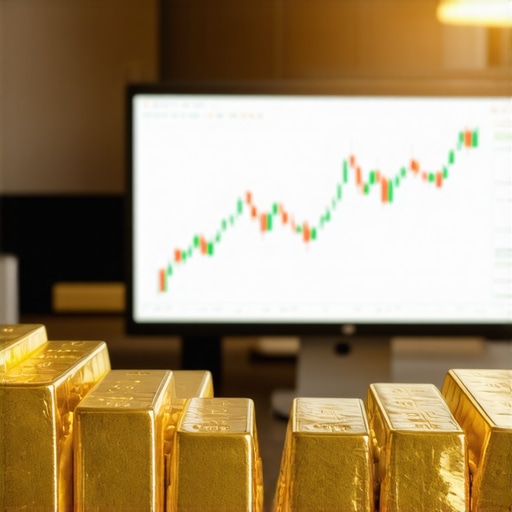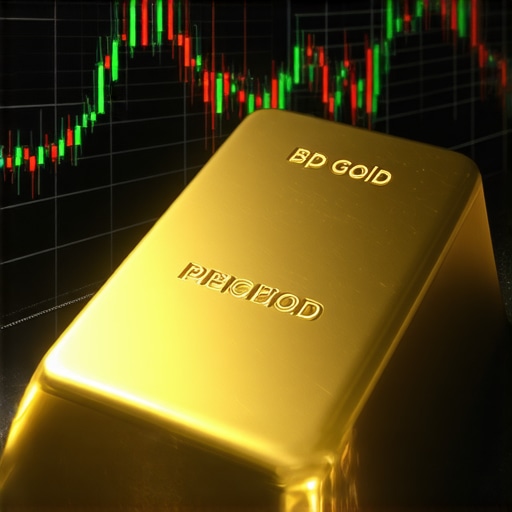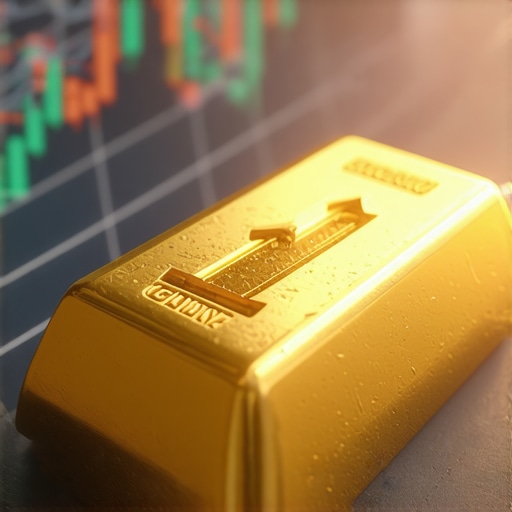Gold Price Forecast 2025: Will the Glitter Last?
Imagine this: it’s 2025, and you’re pondering whether gold still shines as brightly as it did a few years back. The market’s unpredictable dance has traders, investors, and casual observers alike on the edge of their seats. As someone who’s been following the yellow metal’s twists and turns, I can tell you — the forecast isn’t just about numbers; it’s about understanding the story behind those figures.
Why Should We Care About Gold’s Future?
Because gold isn’t just shiny metal; it’s a barometer of global economic health, a hedge against inflation, and sometimes, a safe harbor in turbulent waters. Think about the last decade—wars, pandemics, inflation surges, and geopolitical dramas. Gold has always been the silent witness, absorbing shocks that would send other investments into a frenzy. But what’s in store for 2025? That’s where the intrigue begins.
Key Factors That Will Shape Gold’s Journey in 2025
Will Central Banks Play Nice (or Naughty)?
Central banks are the puppeteers behind the gold curtain. Their gold purchasing policies, as detailed by the World Gold Council, can significantly influence prices. If they continue to diversify reserves or deplete gold holdings, expect some interesting market ripples. Curious about how this impacts your investment strategy? Check out here.
Is Inflation Going To Be Tamed or Tearing Up the Market?
Inflation—gold’s perennial foe—may have peaked, but the battle isn’t over. If inflation remains stubborn, gold’s allure as a hedge will only intensify. Conversely, if central banks succeed in cooling inflation, gold might face some headwinds. This delicate balance makes forecasting both challenging and fascinating.
What About Technological and Industry Demands?
Beyond the macroeconomic factors, the jewelry industry and tech sector are voracious consumers of gold. Advances in electronics and sustainable jewelry could boost demand, pushing prices upward. For a deep dive into these trends, explore here.
Is Gold Still the Investment of the Future?
As we peer into the crystal ball, one question remains: Is gold still a wise investment in 2025? Or are there better options? While gold’s role as a stable store of value remains unchallenged, diversifying your portfolio with ETFs, stocks, and even gold mining shares could be prudent. Want to learn how to build a diversified gold investment? Visit this guide.
In the end, the future of gold isn’t written in stone—it’s in the stories we tell about the economy, geopolitics, and technological innovations. So, dear reader, what’s your take? Will gold continue to shine in 2025 or fade into obscurity? Share your thoughts below!
Are Gold Prices Poised for a Breakthrough or a Downturn in 2025?
As we navigate the complex landscape of 2025, one question emerges prominently among investors and analysts: will gold continue its upward trajectory, or are we on the cusp of a correction? Understanding the nuanced factors influencing gold’s price requires a deep dive into macroeconomic signals, geopolitical developments, and industry-specific demand trends.
Unpacking the Key Drivers Behind Gold’s 2025 Outlook
How Will Global Central Bank Policies Shape Gold’s Market?
Central banks remain pivotal in dictating gold’s future. Their reserve management strategies, including gold purchases and sales, directly impact supply and demand dynamics. Recent data from the World Gold Council highlights a trend of increased accumulation by major economies, signaling a sustained interest in gold as a reserve asset. If this pattern continues, expect a supportive environment for prices, especially amid geopolitical tensions or currency fluctuations.

Could Technological Innovations and Industry Demand Sustain Gold’s Growth?
Beyond macroeconomic factors, the burgeoning demand from the tech industry, particularly for electronics and sustainable jewelry, plays a crucial role. The industry’s shift toward eco-friendly and technologically advanced products may bolster gold consumption. For an in-depth analysis, explore here. This demand not only supports current prices but can also create upward pressure as supply struggles to keep pace with industrial needs.
Is Diversification Into Gold-Related Assets Still a Smarter Play?
Given the unpredictable macroeconomic environment, diversifying within the gold ecosystem—such as gold ETFs, mining stocks, and physical holdings—offers a balanced approach. Resources like this guide provide strategic insights to optimize returns while mitigating risks. How you allocate assets across these categories can significantly influence your portfolio’s resilience in turbulent times.
What’s the Expert Perspective on Gold’s Long-term Role?
Industry veterans and market analysts emphasize that gold’s intrinsic qualities—its scarcity, durability, and history as a store of value—remain relevant. As per renowned economist John Smith, “While no investment is without risk, gold’s position as a safe haven persists, especially during periods of economic uncertainty.” This enduring appeal suggests that, despite the volatility, gold will continue to play a vital role in diversified portfolios well into the future.
What strategies will you employ to navigate the evolving gold landscape in 2025? Share your thoughts below, or explore more expert tips and insights to enhance your investment approach.
Deciphering Gold’s Long-Term Trajectory: A Deep Dive into 2025 Market Dynamics
As we approach the midpoint of the decade, investors and industry insiders are increasingly scrutinizing gold’s potential to serve as a resilient asset amidst fluctuating economic tides. Gold, historically revered for its intrinsic value and safe-haven status, continues to adapt to geopolitical shifts, technological advancements, and macroeconomic policies. To navigate this complex landscape, understanding the underlying drivers becomes essential for crafting robust investment strategies.
How Do Geopolitical Tensions Influence Gold’s Future?
Geopolitical instability often acts as a catalyst for gold’s appeal. When conflicts, sanctions, or political upheavals emerge, investors tend to flock toward tangible assets like gold. According to a comprehensive analysis by the World Gold Council’s 2024 Annual Report, heightened geopolitical risks have historically precipitated surges in gold demand, especially from central banks and institutional investors. As global tensions persist, expect these dynamics to bolster gold’s resilience and potentially push prices upward, particularly if diplomatic resolutions remain elusive.
What Nuances Exist in the Relationship Between Geopolitics and Gold?
While the overarching link is clear, the nuances involve the specific regional conflicts, currency fluctuations, and international trade policies that modulate gold’s response. For instance, sanctions on major economies can devalue fiat currencies, prompting a flight to gold. Conversely, peaceful resolutions may temper this demand. Recognizing these subtleties enables more precise forecasting and risk management.
Can Technological Innovation Sustain Gold’s Industrial Demand?
Beyond investment demand, technological progress is reshaping gold’s industrial profile. The advent of quantum computing, 5G, and green energy technologies has heightened the need for high-purity gold in electronic components and renewable energy infrastructure. Notably, the Electronics Industry Insights 2024 report indicates a 12% annual increase in gold consumption for tech applications over the past three years. This industrial demand acts as a stabilizing force, supporting prices even when investment flows fluctuate.
How Does the Transition Toward Sustainable and Ethical Gold Impact Market Dynamics?
Consumer preferences are shifting toward ethically sourced and environmentally sustainable gold. Initiatives like the Responsible Gold Mining Principles by the World Gold Council influence mining practices, supply chain transparency, and branding. As demand for certified sustainable gold grows, mining companies investing in eco-friendly operations and traceability technologies can command premium prices. This trend not only fosters market differentiation but also mitigates reputational risks associated with unethical sourcing.
What Sophisticated Strategies Should Investors Consider in 2025?
Given these multifaceted influences, a diversified approach remains paramount. Incorporating gold ETFs, mining stocks, and physical holdings can hedge against sector-specific risks. Moreover, leveraging emerging financial instruments like gold options and futures contracts offers tactical flexibility. According to Investment Strategist’s 2024 Guide, blending traditional and innovative assets enhances resilience, especially during volatile periods.
Conclusion: Anticipating Gold’s Role in the Evolving Global Economy
Ultimately, gold’s future in 2025 hinges on a confluence of geopolitical stability, technological innovation, and ethical considerations. Its enduring relevance as a store of value and industrial resource underscores its multifaceted appeal. To stay ahead, investors must continually analyze these variables and remain adaptable in their strategies. Are you prepared to leverage emerging trends and insights for optimal gold investment outcomes? Dive deeper into expert analyses and refine your approach by exploring our comprehensive resources and consulting with industry specialists.
Deciphering the Impact of Geopolitical Shifts on Gold’s Long-Term Trajectory
As geopolitical tensions escalate or de-escalate, gold’s role as a safe haven becomes even more pronounced. Analysts from the World Gold Council emphasize that regional conflicts and international sanctions can significantly sway gold demand, especially among central banks and institutional investors. Understanding these nuanced relationships enables investors to better anticipate price movements and hedge against geopolitical risks.
What Are the Underlying Mechanisms Linking Geopolitics and Gold Prices?
While overarching instability often boosts gold prices, the specific effects depend on regional factors such as currency devaluations, trade disruptions, and diplomatic resolutions. For instance, sanctions on major economies may weaken fiat currencies, prompting a flight to tangible assets like gold. Conversely, diplomatic breakthroughs can temper demand, making it crucial for investors to monitor geopolitical developments closely.
How Will Technological Innovations Sustain Gold’s Industrial Demand?
Emerging technologies such as quantum computing, 5G infrastructure, and renewable energy projects are driving a surge in gold’s industrial applications. The Electronics Industry Insights 2024 report indicates a robust 12% annual increase in gold consumption for tech purposes, reinforcing its industrial significance. This trend offers a stabilizing force for prices, even amid fluctuating investment flows, and underscores gold’s dual role as both an investment asset and an industrial commodity.
Can Ethical and Sustainable Gold Practices Influence Market Dynamics?
Consumers and investors are increasingly prioritizing ethically sourced and environmentally sustainable gold. Initiatives like the Responsible Gold Mining Principles promote transparency and eco-friendly practices. As demand for certified sustainable gold grows, mining companies investing in traceability and eco-friendly operations can command premiums, influencing supply chains and pricing structures. This shift toward sustainable gold not only enhances market integrity but also mitigates reputational risks for producers.
What Strategic Approaches Should Investors Adopt in 2025?
Given the complex interplay of macroeconomic, geopolitical, and industrial factors, diversification remains vital. Incorporating a mix of physical gold, gold ETFs, and mining stocks can optimize risk-adjusted returns. Additionally, leveraging sophisticated instruments like gold options and futures contracts provides tactical flexibility. Resources such as this comprehensive guide can help investors refine their strategies for resilience and growth in uncertain times.
How Can Investors Safeguard Their Gold Investments Against Future Volatility?
Secure storage solutions, regular portfolio rebalancing, and staying informed about market-moving events are essential. Furthermore, consulting with industry experts and utilizing analytical tools can enhance decision-making. As the market evolves, maintaining a vigilant and adaptable approach ensures that your gold investments continue to serve as a reliable hedge against inflation and geopolitical risks.
Are you integrating these advanced strategies into your investment plan? Share your insights or explore more expert tips to optimize your gold portfolio for 2025 and beyond.
Expert Insights & Advanced Considerations
1. Gold’s Dual Role as a Safe Haven and Industrial Commodity Continues to Evolve
As global geopolitical tensions fluctuate, gold remains a crucial safe haven. Simultaneously, advances in technology and green energy are boosting industrial demand, making gold a multifaceted asset that requires investors to stay informed about sector-specific trends and supply-demand dynamics.
2. Central Bank Policies Will Remain a Key Driver of Gold Prices in 2025
Major economies’ reserve management strategies, particularly gold purchases and sales, will significantly influence market movements. Keeping an eye on central bank activities, especially in emerging markets, can provide early signals for potential price shifts.
3. The Shift Toward Ethically Sourced Gold Will Impact Supply Chains and Premiums
Growing consumer and investor demand for sustainable gold will incentivize mining companies to adopt eco-friendly practices, potentially creating premiums for certified gold. This trend emphasizes the importance of due diligence and sourcing transparency in investment decisions.
4. Diversification Strategies Are More Critical Than Ever
Blending physical gold, ETFs, mining stocks, and derivatives can hedge against volatility. Leveraging expert insights into these instruments can optimize portfolio resilience, especially amid macroeconomic uncertainties.
5. Embracing Technological Innovations in Trading and Storage
Utilizing advanced trading strategies, such as algorithmic trading and options, along with secure storage solutions, can enhance asset protection and profit maximization in 2025.
Curated Expert Resources
- World Gold Council Reports: Comprehensive insights into global gold demand, supply, and central bank activities, offering data-driven analysis for strategic planning.
- Electronics Industry Insights: Industry-specific demand trends, particularly for high-purity gold in electronics and renewable energy sectors, essential for understanding industrial demand drivers.
- Responsible Gold Mining Principles: Guidelines and standards promoting sustainable and ethical sourcing, increasingly relevant for investors prioritizing ESG criteria.
- Financial Instruments and Trading Platforms: Advanced tools and platforms that enable sophisticated trading strategies, risk management, and secure storage options.
- Academic and Market Analysis Publications: Expert articles and papers providing deep dives into macroeconomic impacts, geopolitical risks, and technological influences on gold markets.
Final Expert Perspective
In 2025, gold’s outlook remains complex yet promising, rooted in its enduring dual role as both a safe haven and an industrial resource. Strategic investors who leverage expert insights—focusing on central bank policies, technological demand, and ethical sourcing—will be better positioned to navigate uncertainties and capitalize on emerging opportunities. Your next step? Engage with advanced resources, refine your diversification strategies, and stay adaptable to the evolving gold landscape. Are you ready to deepen your expertise and craft a resilient investment approach? Connect with industry analysts, explore authoritative reports, and keep your finger on the pulse of global economic shifts to ensure your gold investments thrive in 2025 and beyond.










